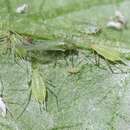The potato aphid Macrosiphum euphorbiae
(
Inglês
)
fornecido por EOL authors
The potato aphid Macrosiphum euphorbiae infests over than 200 plant species in more than 20 plant families, including several commercially important crops. M. euphorbiae originated in North America but it has spread to the temperate parts of Europe and Asia and is found in all areas in which potatoes are grown. It has been introduced into Europe in 1917 and infestations occur commonly on potato, beet, cabbage, glasshouse plants (such as lettuce, endive, red pepper, aubergine and cucumber), wild plants and flowers, including silver ragwort (Senecio), Chrysanthemum, dahlia, carnation and pink (Dianthus). M. euphorbiae aphids range from light green, yellowish green to pinkish red greyish-green to pink, spindle-shaped with antennae longer than body and brown on the apical half; its siphunculi are cylindrical and very long; cauda finger-shaped with 8-11 setae. It often has a darker stripe down the centre of its back, especially in immature nymphs. This species has noticeably long legs, and two long siphunculi at the rear end. The potato aphid colonies increase rapidly from early spring onwards and can double in less than 3 days, and 30 to nymphs may produced by each virginopara. It can cause physical damage to foliage resulting in yield loss when populations are high. In lettuce crops small numbers can persist late into autumn and will affect marketability. On the contrary, it is of little importance in the field as a virus vector of potato viruses, even if it can transmit over 50 plant viruses, mainly of the non- persistent variety, but less efficiencly than Myzus persicae. In particular it is known to transmit the potato leaf roll virus, the beet mild yellowing virus, the beet yellows virus and the lettuce mosaic virus. The parthenogenetic females of M. euphorbiae showed a chromosome number of 2n=10.
- licença
- cc-by-3.0
- direitos autorais
- Mauro Mandrioli

